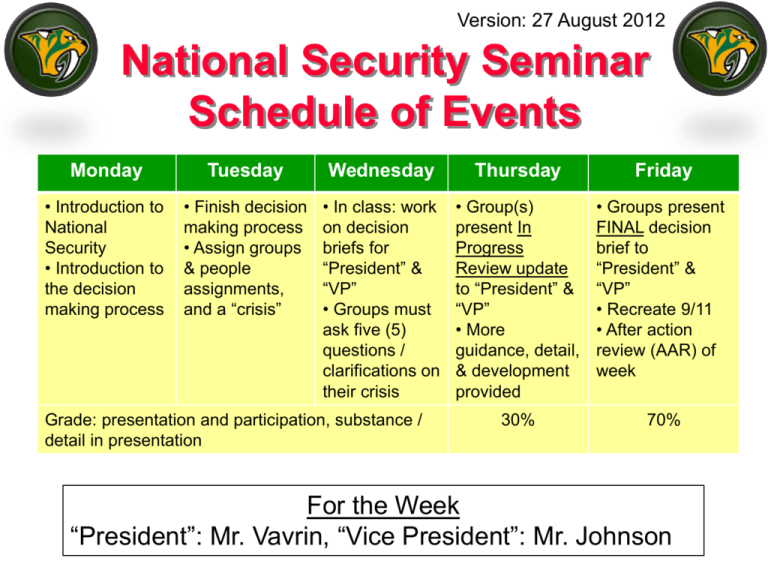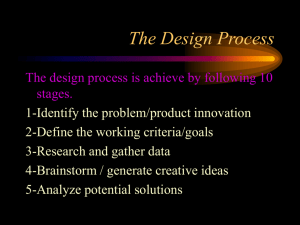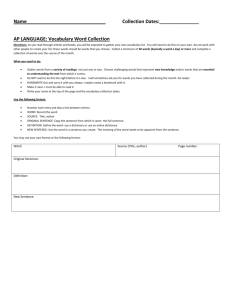Elements of Power and Decision Making
advertisement

Version: 27 August 2012 National Security Seminar Schedule of Events Monday Tuesday Wednesday Thursday Friday • Introduction to National Security • Introduction to the decision making process • Finish decision making process • Assign groups & people assignments, and a “crisis” • In class: work on decision briefs for “President” & “VP” • Groups must ask five (5) questions / clarifications on their crisis • Group(s) present In Progress Review update to “President” & “VP” • More guidance, detail, & development provided • Groups present FINAL decision brief to “President” & “VP” • Recreate 9/11 • After action review (AAR) of week 30% 70% Grade: presentation and participation, substance / detail in presentation For the Week “President”: Mr. Vavrin, “Vice President”: Mr. Johnson Version: 27 August 2012 National Security Seminar Alternate Schedule of Events Monday Tuesday Wednesday • Introduction to National Security • Introduction to the decision making process • Finish decision making process • Assign each section a “crisis” • Divide section into 4 groups and have them work one of the “DIME” elements • In class: work on decision briefs for “President” & “VP” • Groups must ask five (5) questions / clarifications on their crisis • “Evolve” crisis Grade: presentation and participation, substance / detail in presentation Thursday Friday • Group(s) present to “President” & “VP” • Recreate 9/11 • AAR 100% For the Week “President”: Mr. Vavrin, “Vice President”: Mr. Johnson Version: 1 November 2012 National Security Seminar Schedule of Events Monday Tuesday Wednesday Thursday • Introduction to National Security • Introduction to the decision making process • Finish decision making process • Assign groups & people assignments, and a “crisis” • In class: work on decision briefs for “President” & “VP” • Groups must ask five (5) questions / clarifications on their crisis • Continue Work • One Group presents FINAL decision brief to “President” & “VP” (20 min) Grade: presentation and participation, substance / detail in presentation 100% Friday • One Group presents FINAL decision brief to “President” & “VP” (20 min) • Recreate 9/11 • After action review (AAR) of week 100% For the Week “President”: Mr. Vavrin, “Vice President”: Mr. Johnson National Security (homework for weekend, prepare to discuss) • What is National Security ? • What authority (document(s)) gives national security powers and responsibilities to senior government leaders (i.e. President, Secretary of State, etc.) ? • What are some limitations in using National Security ? (Give three (3) examples) • How does $ influence national security ? • Where are we using those elements of power today? Give four (4) examples and what “DIME” element(s) are used References Read: 2010 National Security Strategy (portions) Investigate: Web sites of various federal agencies Name & Describe Threats to our National Security ? • • • • • • • • • • • Terrorism Can you give Cyber-warfare specific instances Nuclear Proliferation when some of these Economic Collapse types of threats Man-made disasters occurred ? Natural Disasters Illegal drugs and its trafficking Weapons of Mass Destruction Border Protection Loss of the national electrical grid __________________ National Security “Key Points” POLICY & STRATEGY Strategy OPERATIONS Democracy “Putting words into action” Instruments/Elements of National Power • Diplomatic/Political: The use of a country’s international diplomatic skills and political position to achieve national interests • Informational: The use of a country’s information systems to achieve national interests • Military: The extent a country’s armed forces can be used to achieve national interests. • Economic: The application of a country’s material resources to achieve national interests Elements of National Power “DIME” • Diplomatic (Political) – Leads • • • • Secretary of State Ambassador to UN Country Ambassadors Combatant Commanders – Summits – Conferences – Treaties Elements of National Power “DIME” • Informational – Leads: All Departments (Public affairs offices, news media, etc.) • • • • • • “Cyber-warfare” Internet Radio TV Mail Other Elements of National Power “DIME” • Military – Leads • • • • Secretary of Defense Chairman of the Joint Chiefs of Staff Service Chiefs (Army, Navy, Air Force, Marines) Combatant Commanders – Geographic – Special Operations • JSOC – “National Military Strategy” document Elements of National Power “DIME” • Economic – Leads • Secretary of the Treasury • Secretary of Agriculture – Natural Resources • Coal • Lumber • Ag products: Corn, soy beans, cattle, pork • Other __________________ – Manufactured Products: Airplanes, steel, IT systems – USAID Funds/Projects – Foreign aid through State Dept – Food aid An Overview... Decision-Making Process National Security “Policy into Action” 1 Decision-Making Process • A systematic approach to problem solving. • A leader and staff checklist to ensure key elements of planning are not missed. • Established and proven analytical process. • Tool that assists the leader and staff in developing a plan. • Helps the leader and staff examine a crisis situation or complex issue and reach logical decisions. • Applies thoroughness, clarity, sound judgment, logic, and professional knowledge to reach a decision. 6 Steps RECOGNIZE & DEFINE PROBLEM GATHER FACTS MAKE ASSUMPTIONS DEVELOP POSSIBLE SOLUTIONS ANALYZE EACH SOLUTION COMPARE SOLUTIONS SELECT BEST SOLUTION 5 QUESTIONS? Lets go through an example National Security Crisis RECOGNIZE & DEFINE PROBLEM GATHER FACTS MAKE ASSUMPTIONS DEVELOP POSSIBLE SOLUTIONS ANALYZE EACH SOLUTION COMPARE SOLUTIONS SELECT BEST SOLUTION Event A large (1/2 mile across) F5 tornado ripped through Houston, TX severely damaging numerous oil refineries, crippling the U.S. oil and gas supplies. National Security Crisis RECOGNIZE & DEFINE PROBLEM GATHER FACTS MAKE ASSUMPTIONS DEVELOP POSSIBLE SOLUTIONS ANALYZE EACH SOLUTION COMPARE SOLUTIONS SELECT BEST SOLUTION Problem(s): 1. Oil and natural gas production has severely decreased 2. There is a terrible environmental disaster in Houston with all the crude oil and gas uncontained and seeping into the ground. 3. There has been loss of life and severe injury. 4. There has been a severe loss of personal and company property. 5. _________________________ National Security Crisis RECOGNIZE & DEFINE PROBLEM GATHER FACTS MAKE ASSUMPTIONS DEVELOP POSSIBLE SOLUTIONS 1. 2. 3. 4. 5. ANALYZE EACH SOLUTION 1. COMPARE SOLUTIONS 2. 3. SELECT BEST SOLUTION 4. 5. Facts: Estimated 1M gallons of oil and gas soaked into ground Oil and gas now contained 5 people dead 20 people injured $100M in damage to facilities Assumptions: Price of gas will go up at least $1.00 / gallon, ~ $5.00 / gal Cleanup will cost $250M Facilities inoperable for at least 30 days OPEC will not ease oil supply Inflation could increase by 5% National Security Crisis RECOGNIZE & DEFINE PROBLEM GATHER FACTS MAKE ASSUMPTIONS DEVELOP POSSIBLE SOLUTIONS ANALYZE EACH SOLUTION COMPARE SOLUTIONS SELECT BEST SOLUTION Solutions: 1. Do nothing 2. Open strategic oil reserves 3. Mobilize national guard for cleanup 4. Talk to OPEC to increase production 5. Activate FEMA to evaluate and distribute goods 6. Ask Red Cross to stage resources 7. Other … ______________ National Security Crisis RECOGNIZE & DEFINE PROBLEM GATHER FACTS MAKE ASSUMPTIONS DEVELOP POSSIBLE SOLUTIONS ANALYZE EACH SOLUTION COMPARE SOLUTIONS SELECT BEST SOLUTION Analyze each solution: Advantages / Disadvantages National Security Crisis RECOGNIZE & DEFINE PROBLEM Compare each solution: GATHER FACTS MAKE ASSUMPTIONS Decision Matrix COA = Course of Action DEVELOP POSSIBLE SOLUTIONS Rate 1 = Best ANALYZE EACH SOLUTION COMPARE SOLUTIONS SELECT BEST SOLUTION COA1 COA2 Cost 1 2 Time to Finish (x2) 4 2 Loss of Life 2 1 External Support 1 2 Total 8 7 Low Score Best COA National Security Crisis RECOGNIZE & DEFINE PROBLEM GATHER FACTS MAKE ASSUMPTIONS DEVELOP POSSIBLE SOLUTIONS ANALYZE EACH SOLUTION COMPARE SOLUTIONS SELECT BEST SOLUTION Select best solution(s): COA(s) “X” National Security Crisis RECOGNIZE & DEFINE PROBLEM GATHER FACTS MAKE ASSUMPTIONS DEVELOP POSSIBLE SOLUTIONS ANALYZE EACH SOLUTION COMPARE SOLUTIONS SELECT BEST SOLUTION Crises: 1. Military 2. Humanitarian 3. Economic 4. Humanitarian 5. Political National Security Crisis Assignment & Rules 1. Deliverables a. Define the problem(s) b. Gather all facts and assumptions c. Develop “courses of action” using “DIME” 2. Rules a. “Brain-storm” courses of action, but … b. No assassinations c. No nuclear weapons or Weapons of Mass Destruction d. No mass devastation, i.e. flooding, etc. 3. Do not work in a “stovepipe” or vacuum, you need to collaborate with other agencies 4. Crisis will evolve over time, expect more bad and/or good news National Security Crisis Group ____________ RECOGNIZE & DEFINE PROBLEM National Security Crisis Group ____________ GATHER FACTS MAKE ASSUMPTIONS National Security Crisis Group ____________ DEVELOP POSSIBLE SOLUTIONS / COURSES OF ACTION “DIME” Backup Slides Decision-Making Process INITIAL GUIDANCE Initiative made STEP 1 or crisis occurs Recognize & Define Problem or Develop Initiative could be more than one problem ASSESSMENT OF AVAILABLE TIME “Warning Order” “Heads Up” RECONNAISSANCE Satellite, person, etc. 8 Military Decision-Making Process MISSION ANALYSIS BRIEF REPORTS, STATEMENTS & SKETCHES STEP 2 GATHER FACTS, MAKE ASSUMPTIONS CDR’s INTENT & INITIAL PLANNING GUIDANCE 10 Decision-Making Process STATEMENTS & SKETCHES Restate Problem Advantages and Disadvantages Reconnaissance Products STEP 3 DEVELOP POSSIBLE SOLUTIONS SOLUTION BRIEFS (OPTIONAL) PRODUCE ONLY VIABLE SOLNs 14 Decision-Making Process APPROVED STATEMENTS & SKETCHES 2nd and 3rd order effects of each option STEP 4 ANALYZE EACH SOLUTION (WAR GAME) REFINED COAs 15 Decision-Making Process STEP 5 EVALUATION CRITERIA COMPARISON POSSIBLE SOLUTIONS DECISION MATRIX DECISION BRIEFING 16 Decision-Making Process LEADER APPROVES STAFF RECOMMENDATION STEP 6 DECISION BRIEF SELECT BEST SOLUTION ISSUE VERBAL ORDERS 17 Decision Making Process Military Operations Order Approved Course(s) of Action STEP 7 Directives PRODUCE THE ORDERS Press Conference 18





